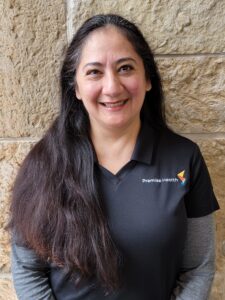A Day in the Life of a Physical Therapist
Every day, you’re on the move – it’s something your body does best. From the moment you get out of bed until the time your head hits the pillow, you’ve walked, talked, waved, stood, lounged, lifted, stretched, bent, and sat.
Even in top condition, your body suffers wear and tear. Like any machine, it requires upkeep. Musculoskeletal conditions are the leading contributor to disability worldwide, affecting more than 1.7 billion people globally. The good news is that many of these challenges can be prevented with early detection and managed with a holistic approach to care.
Physical therapists, chiropractors, and injury prevention specialists, among others, ensure you’re set up for success to maneuver through your days comfortably, whether you’re in need of maintenance or repair. Musculoskeletal health encompasses three tiers: injury prevention, rehabilitation, and optimization. By delivering proactive and holistic care, providers help you feel confident in your ability to enjoy everyday activities. We sat down with Yoheli Perez, a Premise Health physical therapy manager and champion, to learn more about her passion for people and comprehensive approach to therapy that keeps members moving forward, one step at a time.
What are your responsibilities as a physical therapist?
As a champion of physical therapy, I help with projects outside of member care. I train new physical therapists and offer my thoughts and feedback about initiatives we plan to implement, current processes and procedures, approaches to care, and more. As a manager of two other physical therapists, I’m heavily involved in member care, but I also take on administrative duties, provide resources to members, and offer clinical education.

My typical day is member care. At Premise, however, this takes on a different meaning. I get to work directly with members for as long as needed. In many instances, providers are limited on time and a patient may be seen by several physical therapists or technicians over their treatment journey, both of which can compromise the quality of care. I have as much to give as the member needs and am a consistent and active provider, educator, and motivator throughout their time at the wellness center. Our providers can prioritize quality over quantity, allowing us to more effectively and efficiently get our members better. Additionally, because members can be seen more easily, effectively, and with less red tape, we see a broader spectrum of issues. For example, a sore wrist may be ignored until surgery is needed by the average patient, but Premise-affiliated primary care providers encourage members to see a physical therapist before a larger issue arises. We’re able to authentically advocate for the importance of prevention for that reason.
Although member care still takes up the majority of my time, my role has shifted and evolved since I started at Premise. When our wellness center opened in 2019, I was one of the key players responsible for its launch and ensuring we were set up to thrive. Initially, I was very busy treating an influx of new members. Now that we’re established, I have time to dedicate to education, including holding webinars with other clinicians on musculoskeletal topics such as ergonomics, pelvic floor disorders, and headache management. I’m always working to find new avenues to let members know we’re here.
What drew you to direct healthcare?
In this environment, I feel like I’m able to truly make a difference. I appreciate that we put members’ interests above all else and are quick to adapt to a constantly changing landscape. In this role, we’re able to provide early access to physical therapy with fewer barriers, which is important in both prevention and recovery. We make it easy, convenient, and even rewarding for our members to come to the clinic by eliminating the need to locate providers and high-quality, cost-effective care on their own. We take that all into our own hands. We take a team approach in all that we do. Primary care providers will often walk a member over to physical therapy because of a specific issue that came up during their visit. After talking with the member ourselves, we may find out they need some help from a behavioral health specialist too, and we can refer them there. Oftentimes, we walk members to our onsite pharmacy to pick up prescriptions and work cross-functionally with dieticians. The collaboration never ends!
I also collaborate with other team members outside of our wellness center through our Latino professionals and allies team member resource group (TMRG). Though not clinically rooted, many of us bounce ideas off one another in our day-to-day roles for outside perspectives.
How has the musculoskeletal health field changed since you’ve been involved? Where do you see it headed in the future?
There is and likely always will be a strong demand for physical therapy. Now, the field is much more dynamic and includes far more subsets and niches of therapy. In tandem, clinicians are more creative about how to provide these services and meet community needs, with more technology to assist. I see this trend continuing to grow.
Now that there are more ways to treat an individual with varying types of therapy and better technology, coupled with different, oftentimes more sedentary, work environments, and more of an emphasis on wellness, the types of issues we treat are different today than they were when I began practicing 28 years ago. The pandemic was the catalyst for much of this. Now, there is a greater focus on ergonomics as workers began suffering from back and neck pain working from home. We see many members with issues related to poor posture and positions related to excessive stress.
This growing need, in addition to accessibility limitations brought on by COVID-19, prompted virtual physical therapy. This method can’t be used in all situations, but it’s improved reach and has been convenient and beneficial for those whose issues are less serious and can be solved with functional guidance. For example, my wellness center conducts virtual ergonomic assessments in which one of our physical therapists assesses a member’s work-from-home setup and recommends adjustments for optimal positions, equipment, and more. This assessment is done virtually, therefore expanding reach beyond our wellness center to members in other locations throughout the United States. It’s highly effective, preventive, and utilized by our members.
What about your job motivates you?
Our culture and team are second to none. We truly care about people, and it shows in our efforts in and outside of work. This past year, we wrote cards to nursing home residents during the holidays and held a food drive through a local pantry. We make time for fun, too! We celebrate personal and professional successes and milestones on our team, play games together, and volunteer. I’m thrilled to be a part of one of our TMRGs as well, which allows us to collaborate, find solidarity, support each other, and encourage more diversity within the organization.
It goes without saying, but member care keeps me motivated. There is nothing better than building relationships and seeing members get better, healthier, and happier.
How have you influenced the lives of the members you work with?
I took care of a young member who visited the wellness center for shoulder pain during the pandemic. During our time, we realized he had a knee problem that he didn’t initially mention, and we treated that as well. He had just moved to the area and didn’t know anyone, so I jogged with him. A few months later, he finished his first 5K not having ever thought he’d run a mile. His primary care provider also came into the wellness center to show how much weight he’d lost since receiving therapy. Not only was his shoulder pain gone, but an issue he didn’t realize he had was resolved, and he was happier and healthier.
I worked with another member who had a history of knee pain and was tired of her doctor only offering injections to ease the discomfort. She was offered the opportunity to try physical therapy with the goal of being able to dance. During her rehab, I turned on Cupid Shuffle and we would dance together. Though her journey was full of challenges, she was determined. She improved so much that she no longer needed a walker to get around and started a Zumba club on her own with a few of her neighbors. I’m privileged to watch our members regain their confidence and experience the joy in everyday activities that many of us take for granted.
At Premise, we make prevention part of your everyday through a responsive care experience, tailored wellness programs, and customizable and accessible services. Our team of physical, occupational, and massage therapists, chiropractors, and acupuncturists help prevent injuries and get members feeling their best, all while staying ahead of elevated healthcare costs.
To learn more about Premise musculoskeletal care, click here.
Next on industry insights.

Redefining Rest: The Power of Taking a Break
Read the Blog
You’ve Opened a Wellness Center. Now What?
Read the Blog